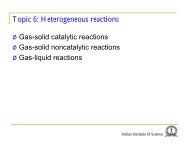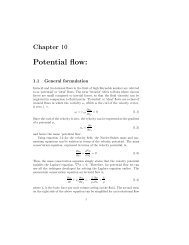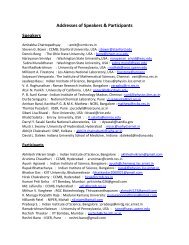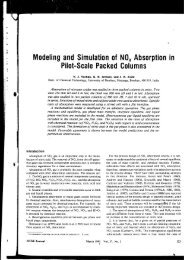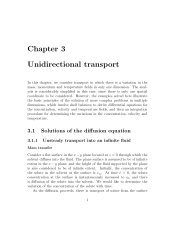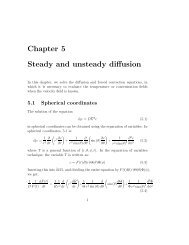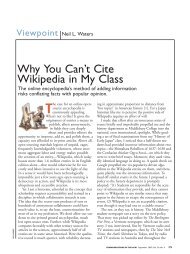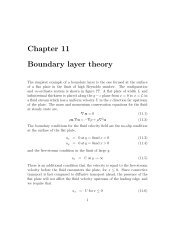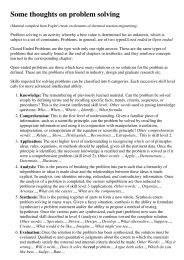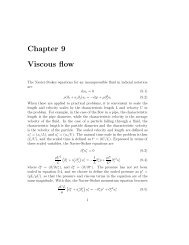Potential flow:
Potential flow:
Potential flow:
Create successful ePaper yourself
Turn your PDF publications into a flip-book with our unique Google optimized e-Paper software.
1.2. THREE-DIMENSIONAL POTENTIAL FLOWS 9In the above equation, we have returned to a co-ordinate system in which theorigin is located at the center of the particle. The radial component of the fluidvelocity, u r , at the surface is zero, and the only contribution to the kinetic energyis due to the tangential velocity at the surface, u θ (equation 1.8). Therefore,the pressure at the surface r = R is given by,( u2p = p 0 − ρ θ2 + U sin (θ)u θ − R cos(θ) dUdt)= p 0 − ρU 2 (5 sin (θ) 216− R U 2 cos(θ)dU dt)(1.18)In equation 1.19, we have substituted U θ = −U sin (θ) and u θ = (U sin (θ)/2)at r = R.The force exerted on the sphere can be calculated by integrating the pressureover the surface of the sphere,∫F i = dSτ ij n jS sphere∫= dSpn i (1.19)S sphereBy symmetry, the force perpendicular to the velocity is zero. The force alongthe direction of the velocity is,∫F z = dSpn z (1.20)S spherewhere F z is the force in the direction of the velocity vector, and n z is thecomponent of the unit normal to the sphere in the direction of the velocityvector. For the steady <strong>flow</strong> of a particle with (dU/dt) = 0, it can easily beshown that the force F i is identically zero due to symmetry considerations. Thepressure p is a symmetric function of θ about the mid-plane cutting the sphereperpendicular to the direction of <strong>flow</strong> at θ = (π/2). However, the unit normaln z = cos(θ) is anti-symmetric about the plane θ = (π/2), and therefore theintegral of the pressure and n z over the surface of the sphere is identically zero.This result, that the steady motion of a sphere through a fluid does not exert aforce on the fluid, is referred to as ‘d’Alembert’s paradox’.If the particle is accelerating, there is a net force exerted on the particle bythe fluid. This is calculated by integrating the contribution to the pressure dueto acceleration over the surface of the sphere.∫F i = ρS sphere= ρ ∫dU j2R dt( R 3 ) ∣ x j dU j ∣∣∣∣r=RdSn i2r 3 dtdSx i x jS sphere



